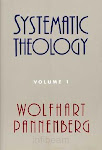The Emergence of the Catholic Tradition (100–600) is the first volume of Jaroslav Pelikan’s five-volume history of Christian doctrine, The Christian Tradition: A History of the Development of Doctrine. Jaroslav Pelikan (1923–2006) was the Sterling Professor of History Emeritus at Yale University and the author of numerous volumes on the history of Christianity.
His The Christian Tradition is truly a massive project, written in clear understanding of its challenging magnitude, as the very first (sober) sentence of volume one’s preface attests: “The Emergence of the Catholic Tradition begins the publication of my history of Christian doctrine, which I hope to complete in five volumes within the next decade” (p. ix).
New quotation system - easy to read
This first volume is based on a study of the primary sources in the original languages – Greek, Syriac, and Latin. The most striking, most original, and most
 welcomed methodological trait of the whole series is – from the point of view of the average reader – the total absence of not only references to sources within the text but also of all footnotes whatsoever.
welcomed methodological trait of the whole series is – from the point of view of the average reader – the total absence of not only references to sources within the text but also of all footnotes whatsoever.The author uses a system of marginal annotations, a system I hope catches on in future monographs too. It serves the interest of both the scholar and layman simultaneously, “without intruding the apparatus of erudition on the reader who is not interested (not yet interested or no longer interested) in the footnotes” (p. x).
The author's strengths
The author’s command of English is excellent, making reading both easy and exhilarating. The dialogue, say, between Greeks and early Christian apologists is at times hilarious, but Pelikan masterfully shows it to be relevant to the development of doctrine (see, for example, the chapter "The Christian Dispute with Classical Thought"). As an example of the author’s style, here is a most clever, apt, concise, and humorous ending to his treatment of the Trinitarian so-called homoousios-homoiousios debate:
“By saying that Christ was ‘of the ousia’ of the Father and ‘like [the Father] in ousia,’ they were, he [Athanasius] continued, ‘settling themselves in opposition to those who say that the Logos is a creature.’ And this was finally the doctrinal interest for which homoousios had been a symbol – coined by the Gnostic heretics, dictated by an unbaptized emperor, jeopardized by naive defenders, but eventually vindicated by its orthodox opponents.” (p. 210.)
The author’s primary sources are, in addition to the ordinary apologetics and "against heresy" material, liturgical and exegetical in nature (see p. 11). He does not “psychoanalyze” the authors of his sources, thank God. He shows wholesome reserve, as psychoanalyzing is, indeed, a questionable tool, especially when wielded across the distance of several centuries.
(As a side note, I will have to make a decision regarding the approach I will take in my own dissertation on John Paul II’s and C.S. Lewis’ conceptions of love. Biographical treatments are undoubtedly needed, and contrary to Pelikan and his subject matter, I and my “subject matter” share closer proximity in time. Although both men, Lewis and John Paul II, left behind a considerable body of personal material (in form of texts), caution must be used as I analyze it.)
Continuing with the author’s strengths, it must be stated that he shows remarkable impartiality and objectivity when dealing with sensitive questions – and this characteristic stands out even without counter-examples, such as Bernhard Lohse, still lingering in my memory. Pelikan, it seems, has refused to borrow “Lohse’s Lutheran lenses”, and nothing in the first volume comes even close to a blatantly one-sided statement, such as Lohse’s, “All the appeals to tradition cannot alter the fact that nowhere does tradition count for less than it does in the Roman church” (History of Christian Doctrine 1985, p. 211).
I was aware of Pelikan’s biographical background and the major transition in his later life. However, without this knowledge, there is little in this first volume that could betray his personal denominational affiliations.
"Church catholic"?
The only exception to this was the expression “church catholic”, which appeared over and over again (e.g. p. 123) and by which I take him to mean the “early Christian mainstream church”. The word order – “church catholic” instead of “catholic church” – stands out.
Why would he use such a clumsy (and revealing?) word order? To make an ecclesiological point (“the early Christian church is not the so-called Catholic Church”)?
If so, it is at the expense of proper English – after all, the volume is named The Emergence of the Catholic Tradition and not The Emergence of the Tradition Catholic – and perhaps invites suspicion of feelings of inferiority. Similarly, I find it amusing that we modern Protestants or non-Catholics insist on saying the Roman Catholic Church instead of simply the Catholic Church (meaning, “Rome has no exclusive rights to the word ‘catholic’!”).
In the next part we move on from more general observation to the substance of the book, to dogma itself and a few interesting dogmatic themes.







No comments:
Post a Comment